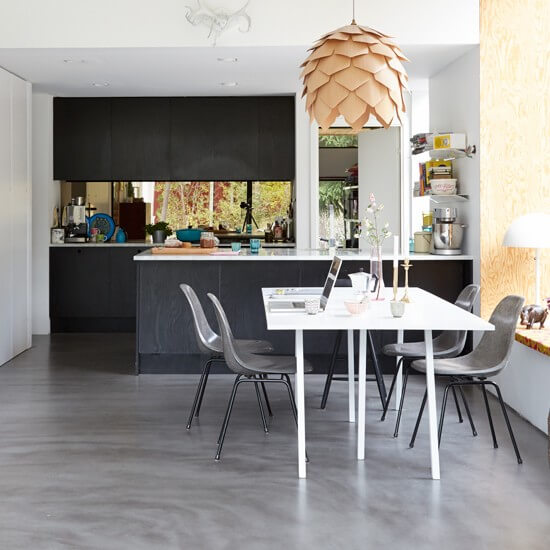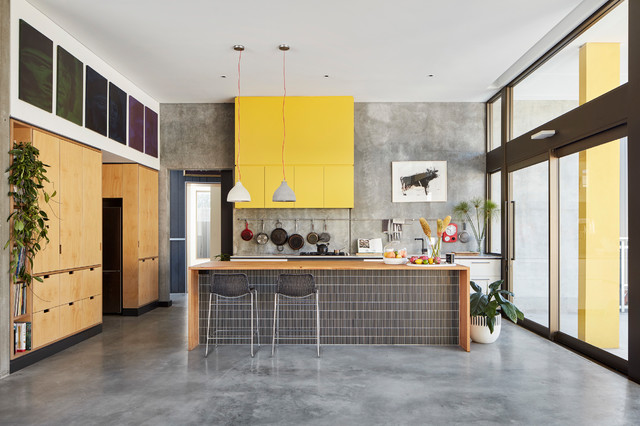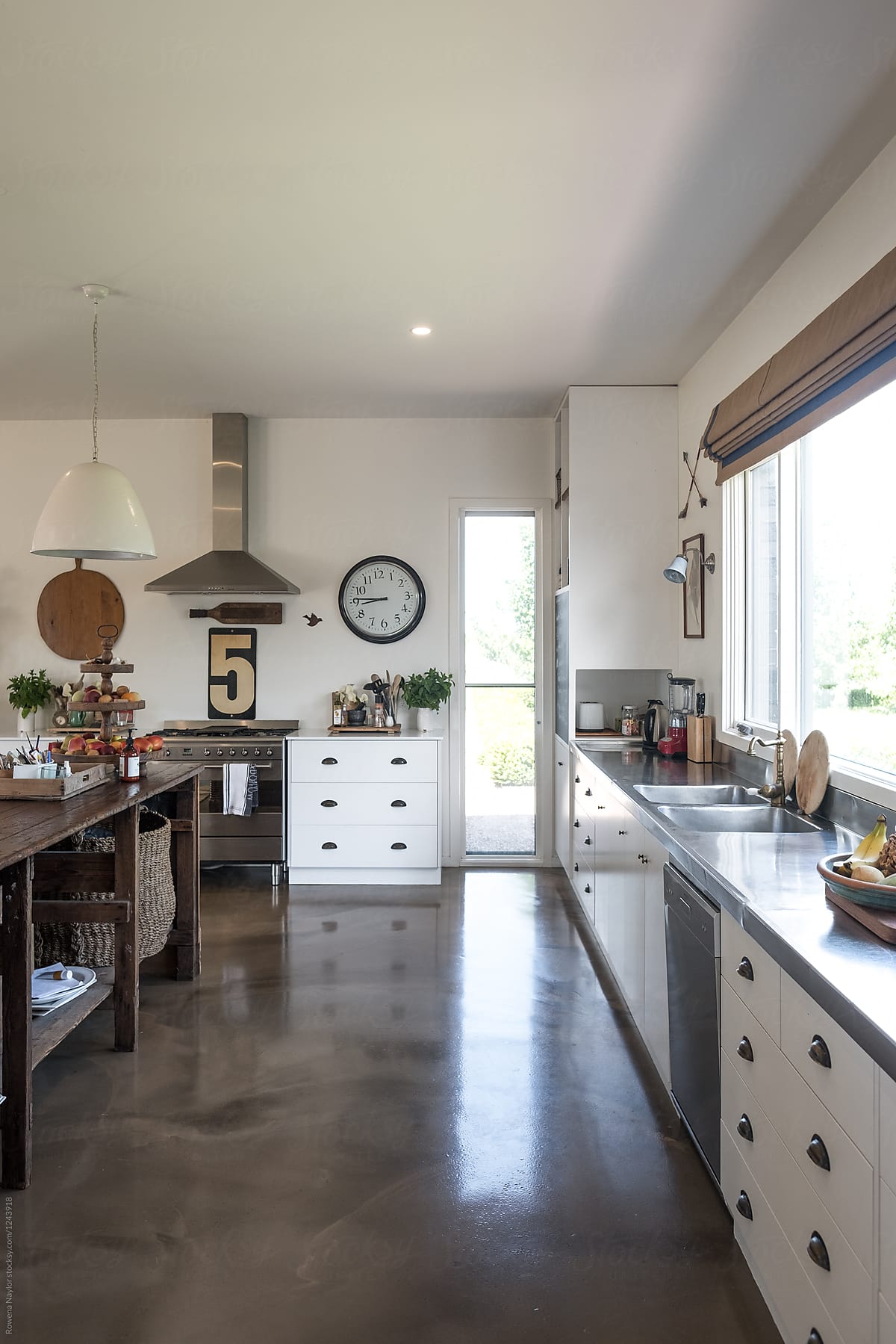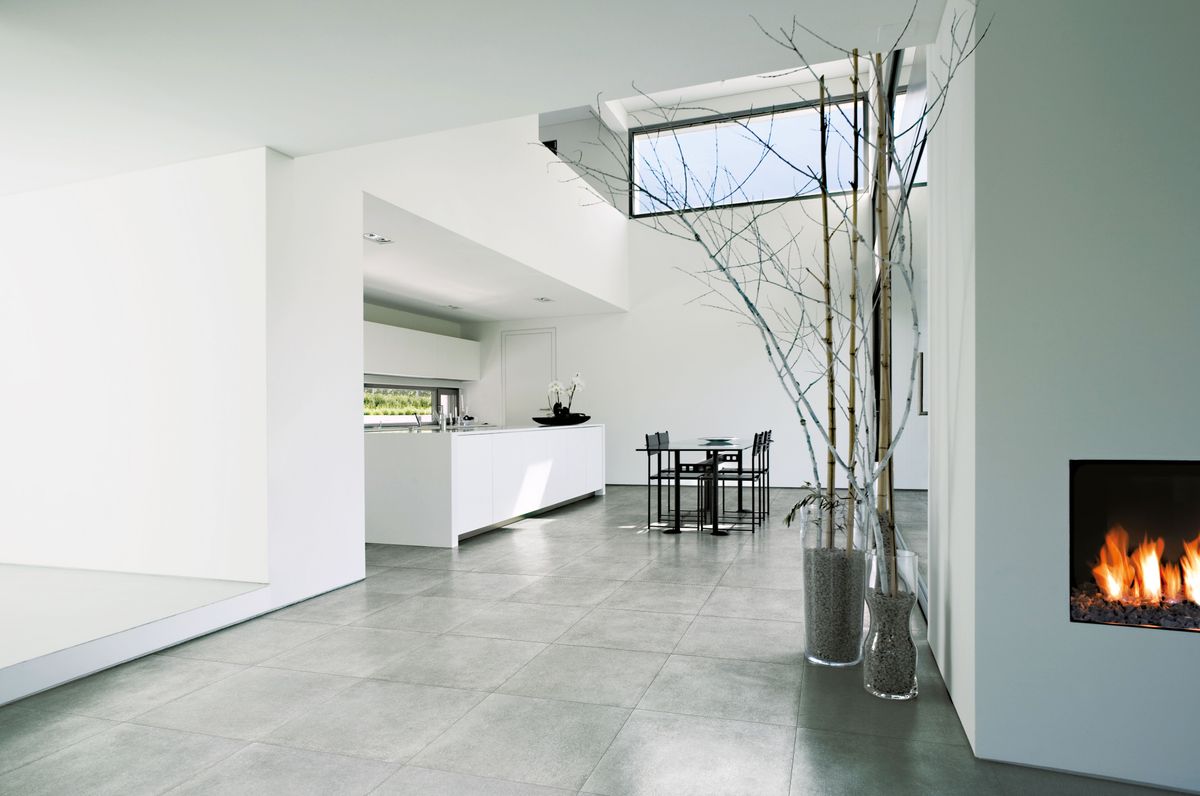Why Choose Concrete Flooring for Your Kitchen?
When I was first exploring flooring options for my kitchen, concrete wasn’t even on my radar. But after digging into the benefits, I realized it might just be the unsung hero of kitchen flooring. Let me walk you through why concrete flooring could be a game-changer for your kitchen too.
- Durability That Lasts a Lifetime: Concrete is as tough as it gets. This flooring can handle just about anything—from heavy foot traffic to dropped pots and pans—without showing signs of wear and tear. It’s the kind of investment that pays off in the long run, as you won’t be worrying about replacing it anytime soon.
- Low Maintenance, High Reward: One of my favorite things about concrete flooring is how low maintenance it is. With just a regular sweep and occasional mop, your floors will stay looking fresh. Plus, sealed concrete is resistant to stains and water damage, making it perfect for a busy kitchen.
- Endless Customization Options: Concrete is like a blank canvas. Whether you want a sleek, polished look or a textured, rustic vibe, concrete can do it all. You can even add color stains or etch designs to make it uniquely yours. The possibilities are endless!
- Eco-Friendly and Sustainable: If you’re conscious about your environmental footprint, concrete is an excellent choice. It’s made from natural materials and doesn’t require the same resource-intensive manufacturing processes as other flooring types. Plus, its longevity means fewer replacements and less waste.
- Temperature Control with Radiant Heating: Concrete floors can get cold, but that’s not necessarily a downside. With the option to install radiant heating beneath the surface, you can enjoy a warm, cozy kitchen floor all year round. It’s an efficient way to keep your space comfortable, especially in colder climates.
- Cost-Effective Over Time: While the initial installation might seem pricey, concrete flooring is surprisingly cost-effective over time. Its durability and low maintenance mean fewer repairs and replacements, saving you money in the long run. Trust me, it’s worth every penny.

Popular Finishes for Concrete Kitchen Floors
When I first heard about concrete floors, I pictured a dull, gray slab. But boy, was I wrong! The range of finishes available for concrete floors is nothing short of impressive. If you’re curious about what’s out there, here’s a rundown of some popular finishes that can elevate your kitchen’s look.
Polished Concrete: Sleek and Shiny
Polished concrete is a fan favorite, and for good reason. This finish gives your floor a high-gloss, reflective surface that’s perfect for modern and minimalist kitchens. It’s also incredibly easy to clean, making it both beautiful and practical.
Stained Concrete: Colorful and Versatile
Stained concrete opens up a world of color possibilities. Whether you want earthy tones or vibrant hues, staining can achieve that. Acid-based stains create a variegated, marble-like effect, while water-based stains offer more consistent, solid colors.
Textured Concrete: Grip and Character
If you’re worried about slipping, textured concrete is a great option. It adds grip to your floor, making it safer, especially in a kitchen. From subtle brush strokes to bold, patterned imprints, textured finishes also add character and depth.
Exposed Aggregate: Rustic and Natural
For those who love a more rustic look, exposed aggregate is a stunning choice. This finish reveals the natural stones and pebbles within the concrete, creating a unique, speckled surface that’s both durable and visually interesting.
Epoxy Coating: Durable and Decorative
Epoxy coatings take concrete floors to the next level. Not only does it protect your floor from scratches and stains, but it also allows for custom designs. You can even add metallic pigments or color flakes for a one-of-a-kind look.
Matte Finish: Subtle and Sophisticated
If high-gloss isn’t your style, a matte finish might be more up your alley. This finish offers a subtle, non-reflective look that’s both chic and understated. It’s perfect for those who want a modern aesthetic without the shine.
Concrete Floor Colors and Stains for a Modern Look
Concrete floors don’t have to be boring. In fact, with the right color and stain, they can be the star of your kitchen. If you’re aiming for a modern look, here are some ideas that might just inspire your next flooring project.
Classic Gray: Timeless and Versatile
Gray is a classic choice for a reason. It’s neutral, versatile, and works with almost any kitchen style. Whether you go for a light, airy shade or a deep charcoal, gray concrete floors are a foolproof way to achieve a modern, sophisticated look.
Warm Earth Tones: Cozy and Inviting
For a warm, welcoming vibe, consider earth tones like beige, brown, or terracotta. These colors add warmth to your kitchen while maintaining a modern feel. They’re especially stunning when paired with natural wood accents.
Bold Black: Dramatic and Chic
Black concrete floors make a bold statement. They’re sleek, dramatic, and undeniably modern. If you want your kitchen to have that wow factor, black is the way to go. Just be sure to balance it with lighter elements to avoid a too-dark space.
White and Light Hues: Bright and Airy
If you love a bright, open kitchen, light-colored concrete floors are a great choice. Whites, creams, and light grays reflect light beautifully, making your space feel larger and more inviting. Plus, they pair well with almost any color scheme.
Metallic Finishes: Futuristic and Glamorous
For something truly unique, consider a metallic finish. Copper, silver, and gold stains add a futuristic touch to your floors. They’re perfect for modern kitchens that need a bit of glam, and they catch the light in the most mesmerizing way.
Custom Color Mixes: Personalized and Unique
If none of the standard colors speak to you, why not create your own? With custom color mixes, you can achieve a shade that’s perfectly tailored to your taste. Whether it’s a soft pastel or a vibrant jewel tone, the sky’s the limit!
Maintenance Tips for Long-Lasting Concrete Floors
One of the best things about concrete floors is how low-maintenance they are. However, a little TLC can go a long way in keeping them looking fresh and new. Here’s how I keep my concrete kitchen floors in tip-top shape.
Regular Sweeping and Dusting
Dust and debris can act like sandpaper on your concrete floors, causing tiny scratches over time. That’s why I make it a habit to sweep or dust mop my floors daily. It’s a quick and easy way to prevent wear and tear.
Mopping with the Right Cleaners
When it comes to mopping, less is more. I use a damp mop and a pH-neutral cleaner to avoid damaging the floor’s sealant. Harsh chemicals or too much water can break down the seal, so it’s best to stick with gentle, non-abrasive products.
Sealing the Surface
Sealing is crucial for protecting concrete floors from stains and moisture. I reseal mine every couple of years to keep them looking their best. If your kitchen sees a lot of traffic, you might need to do it more often. Trust me, it’s worth the effort!
Addressing Stains Promptly
Even though sealed concrete is resistant to stains, accidents happen. I always clean up spills right away to avoid any long-term damage. For tougher stains, a mild detergent and soft brush usually do the trick.
Protecting High-Traffic Areas
Rugs and mats are your best friends in high-traffic areas like in front of the sink or stove. They help minimize wear and tear on the floor, and they add a cozy touch to your kitchen. Plus, they’re easy to switch out when you need a change.
Avoiding Scratches and Gouges
Concrete floors are tough, but they’re not invincible. To prevent scratches, I use furniture pads under chair legs and avoid dragging heavy objects across the floor. A little caution goes a long way in keeping your floors scratch-free.
Creative Ways to Style Concrete Kitchen Floors
Concrete floors might seem plain at first glance, but they’re actually incredibly versatile. With a few creative touches, you can turn them into a stylish focal point in your kitchen. Here are some ideas I’ve used (and loved) to style concrete floors.
Layering Rugs for Warmth and Texture
Rugs are an easy way to add warmth and texture to your concrete floors. I love layering different sizes and patterns to create a cozy, eclectic look. Plus, they’re great for defining different areas in an open-plan kitchen.
Adding a Pop of Color with Stained Concrete
Stained concrete is perfect for adding a pop of color to your kitchen. Whether you choose a bold red or a subtle green, it’s a great way to inject some personality into your space. The best part? You can mix and match colors for a custom design.
Mixing Materials for Contrast
One of my favorite tricks is mixing concrete with other materials like wood or tile. For example, pairing concrete floors with a wooden kitchen island creates a beautiful contrast between industrial and natural elements. It’s a surefire way to make your kitchen stand out.
Creating Patterns with Stamps and Molds
If you want to get creative, consider using stamps or molds to create patterns on your concrete floor. From geometric shapes to intricate designs, this technique can turn your floors into a work of art. It’s a unique way to add character and charm to your kitchen.
Incorporating Metallic Accents
Metallic accents can make your concrete floors shine—literally. I’ve seen some stunning designs where metallic pigments are added to the concrete mix, creating a shimmering effect that catches the light. It’s a modern, glamorous touch that’s hard to beat.
Going for a Minimalist Look
Sometimes, less is more. A simple, polished concrete floor paired with minimalist decor can create a sleek, modern kitchen. I love the clean lines and uncluttered feel of this style. It’s proof that concrete doesn’t have to be complicated to be beautiful.
Pros and Cons of Concrete Flooring in the Kitchen
Like any flooring option, concrete has its pros and cons. After living with it in my kitchen for a while, I’ve come to appreciate its strengths and accept its weaknesses. Here’s a balanced look at the good and the not-so-good of concrete kitchen flooring.
Pro: Incredible Durability
Concrete floors are built to last. They can handle just about anything—heavy appliances, foot traffic, you name it. This durability is a major plus, especially in a busy kitchen where spills and drops are inevitable.
Con: Hard and Unforgiving
On the flip side, concrete is very hard. While this makes it durable, it also means it’s not very forgiving on your feet or dropped items. Standing on it for long periods can be tough, so cushioned mats are a must.
Pro: Low Maintenance
One of the biggest advantages of concrete is how easy it is to maintain. A quick sweep and mop are usually all it needs. Sealed concrete is resistant to stains and moisture, making it perfect for the kitchen.
Con: Can Be Cold
Concrete tends to stay cool, which is great in summer but not so much in winter. However, this can be easily fixed with radiant heating or by adding area rugs to keep things cozy.
Pro: Endless Design Possibilities
The design possibilities with concrete are almost endless. From polished finishes to intricate patterns, you can customize your floors to suit any style. This versatility is a huge plus for anyone looking to create a unique kitchen.
Con: Cracks Can Develop
Concrete can develop small cracks over time, especially if your home settles or the floor isn’t installed correctly. While these cracks are usually minor and can be repaired, they’re something to keep in mind when choosing concrete.
DIY vs. Professional Installation: Which is Right for You?
When it comes to installing concrete floors, you might wonder if you should go the DIY route or hire a pro. I’ve been in the same boat, and after weighing the options, here’s what I found to help you make the best decision for your kitchen.
DIY: Cost Savings
One of the biggest advantages of DIY is the cost savings. If you’re handy and have some experience, doing it yourself can save you a significant amount of money. Plus, there’s a certain satisfaction in knowing you did it with your own two hands.
Professional: Expertise and Precision
On the other hand, professionals bring expertise and precision to the table. They know the ins and outs of concrete installation, ensuring a smooth, even finish. If you want peace of mind and a flawless result, hiring a pro is the way to go.
DIY: Flexibility and Control
Doing it yourself also gives you more control over the project. You can work at your own pace, make adjustments on the fly, and truly customize your floor. However, be prepared for the time and effort it takes—concrete is not a forgiving material!
Professional: Proper Tools and Materials
Professionals have access to high-quality tools and materials that you might not. This can make a big difference in the outcome. They also know how to handle unexpected issues that could arise during installation, saving you from potential headaches.
DIY: A Learning Experience
If you love learning new skills, a DIY concrete floor could be a rewarding project. There are plenty of tutorials and resources out there to guide you. Just keep in mind that mistakes can be costly, so weigh your confidence level before diving in.
Professional: Guaranteed Results
When you hire a professional, you’re paying for guaranteed results. Many contractors offer warranties on their work, giving you added security. If you’re looking for a stress-free experience and a top-notch finish, a pro is your best bet.
Polished concrete kitchen floor modern home interior design
Polished concrete floor Kitchen decor trends
Concrete flooring: a guide to polished concrete floors
Reasons to Consider Dreamy Concrete Kitchen Floors
Home Sweet Home
Related Posts:










